The holiday association of shrubby Ouhout trees lining mountain streams and hiking trails meant that we were delighted to find an established Ouhout growing in the garden when we moved into our current home some years ago. The Afrikaans name, used also by English speakers, ‘Ouhout’ literally means ‘old wood’, and even young plants have a woody gnarled appearance.
Although not confined to high altitudes the Ouhout (Leucosidea sericea), being frost resistant, thrives in mountain regions and is able to flourish even above 1 100 m to as high as 2 100 m. In mountainous areas, such as in Lesotho, it is the most common – and sometimes the only – indigenous tree to be found. In such regions it is a noted pioneer plant, establishing itself in disturbed ground. Often shrubby in appearance, in the right circumstances it can grow as tall as 9 m.
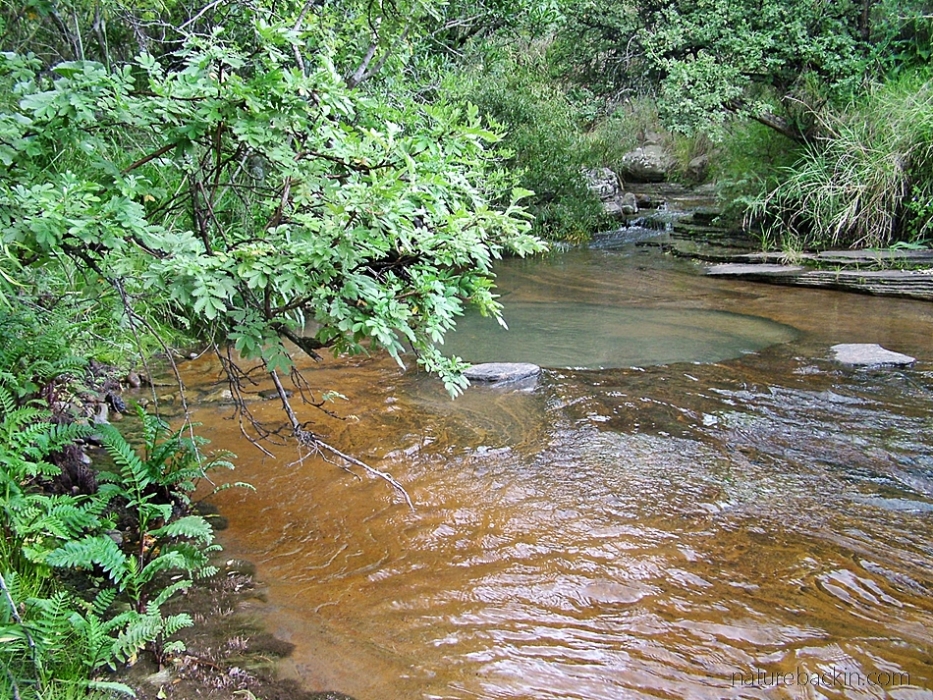
The Ouhout (seen leaning over the water in this photo) commonly lines streams and watercourses. A less frequently used English name, Troutwood, refers to the relationship between Ouhout and mountain streams suitable for stocking with trout. This photo was taken near the Thendele camp in the Royal Natal Park – uKahlamba Drakensberg Park
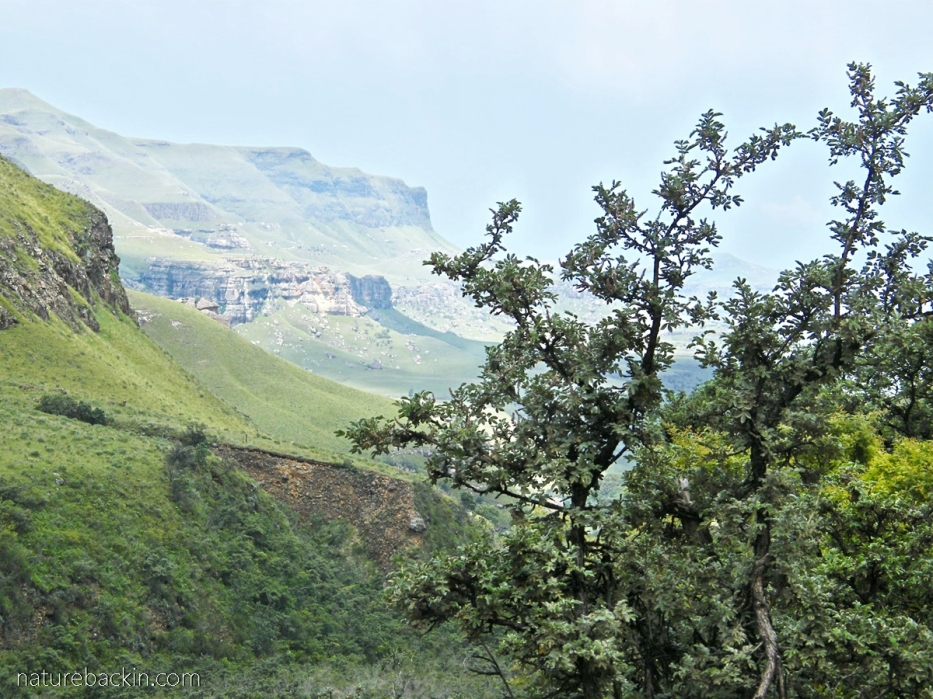
Ouhout in the foreground with the escarpment near Sani Pass on the border with Lesotho visible beyond
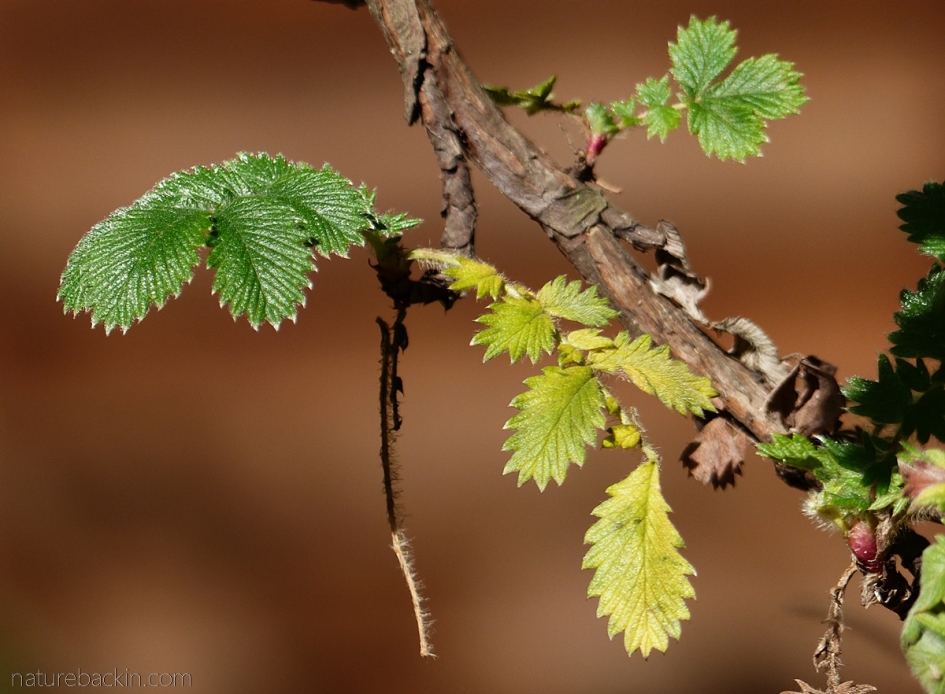
A photo of the Ouhout in our garden. To be more accurate, of the Ouhout that used to be in our garden as over time parts of the tree died off before the entire plant succumbed. Perhaps it had reached the end of its natural lifespan
I have taken it for granted that planting indigenous plants brings many benefits – for example, not only are these plants adapted to local conditions and are water wise, they are diverse and beautiful and also of value to birds, insects and other creatures. Planting indigenous plants promotes local biodiversity in contrast to the domesticated hybrids and cultivars sold as popular garden plants – many of which have their origins in other continents.
However, I have been rethinking some of my taken-for-granted assumptions about planting indigenous plants since a visit (in 2016) to the village of Rhodes in the Highlands of the Eastern Cape. The village was officially founded in 1891 and it was named for Cecil John Rhodes (1853-1902) who at the time was Prime Minister of the Cape Colony. During the 1890s the new village of Rhodes saw the building of its Dutch Reformed Church to serve those who had settled on the surrounding farms, as well as the construction of a post office, court room, jail and school. The population grew to between 250 and 300 people, and many of the Victorian-era cottages that were built then survive today.

The post office building in Rhodes (photographed in 2016). Note the old phone booth on the left – neither it nor the post office itself is functional today
The village of Rhodes saw mixed fortunes that were related to those of the farming community. More prosperous times included a wool boom in the 1950s, but by the 1970s agricultural fortunes had declined and the village became almost derelict. However it has been rediscovered and it is now a holiday and tourism destination, with many of the cottages restored and with the village hosting several annual tourism events, for example linked to sports such as cycling and fly-fishing. Sadly though, current travel restrictions during the Covid-19 pandemic must have impacted severely on the village.
Our stay there back in 2016 was a two-day stopover (in one of the old cottages) on our way back home after visiting the Western Cape. The visit entailed a bit of a detour as the village is remote, being up in the Eastern Cape Highlands just 16 km south of the Lesotho border. While there we visited the local pottery, the Clay Café. Among the ceramic items for sale, I was attracted to some simple ceramic tiles featuring the leaves of the Ouhout.
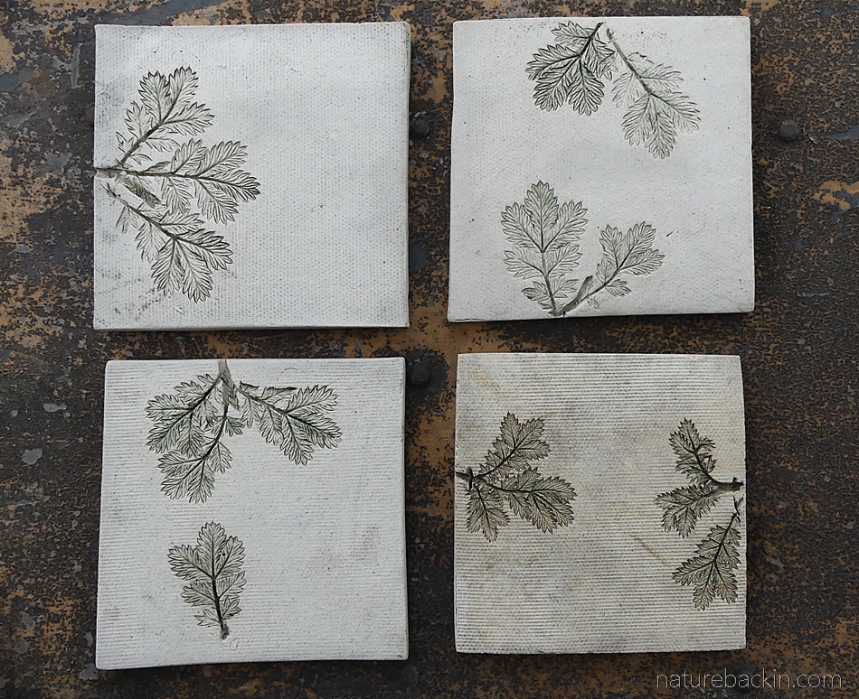
Clay tiles decorated with indentations of leaves of the Ouhout. I bought these tiles while visiting the Clay Café in the village of Rhodes in the Eastern Cape
The Clay Cafe pottery is run by ceramicist Irene Walker, and she explained that the reason why Ouhout leaves are featured in some of the pottery made at the Clay Café is because the Ouhout is the only indigenous tree that grows in the Rhodes area, which is high enough to be above the ‘tree-line’.
The village is 1840 m above sea level and too high, dry and cold for most indigenous trees, but the Ouhout is able to survive in these conditions. Of course European settlers back in colonial times usually planted their gardens, villages and towns with familiar plants from ‘home’, disregarding most of the indigenous plants and trees. But in the instance of the village of Rhodes, from what I can gather when it came to trees – apart from the local and overlooked Ouhout – trees adapted to harsh high altitude conditions and acceptable to the settlers would have been trees familiar to them from Europe.
There is a story that Cecil Rhodes, in recognition of the village being named after him, donated a wagonload of pine trees to the village, some of which are reputed to still be alive today. But in an article on the history of Rhodes village, Dave Walker notes that early photographs of the village debunk this story and the fact that the pine trees in the village today have a lifespan of no more than 70 years means these trees are of far more recent provenance.
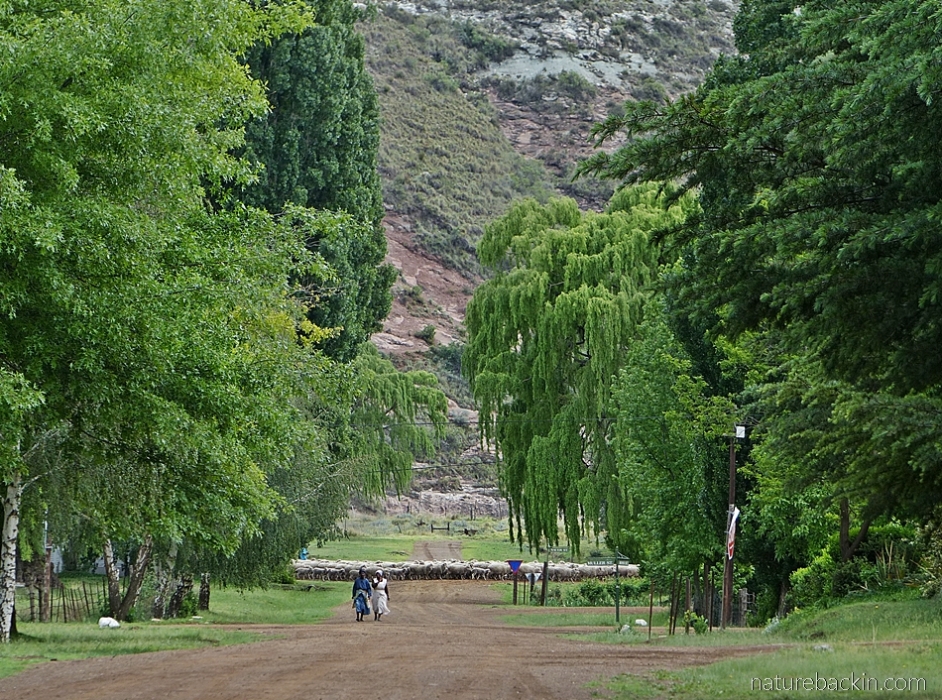
Two women walk up a tree-lined street in the village of Rhodes. A flock of sheep is being shepherded behind them. The trees are all introduced non-indigenous species
So although many of the trees that were planted in and around Rhodes have survived for decades, many are aging and others have been removed or have died. I was interested to see online that a Rhodes Tree Planting Project was initiated in 2008. On the project’s website it says that the idea was “to plant new trees to beautify the village whilst at the same time offset our carbon on our visits to Rhodes”. Plans include planting a new generation of trees to form new avenues, and also mentioned is the need to replace trees to address village firewood requirements
Unfortunately the website does not detail the species of trees to be planted under the auspices of the project, but it notes trees that remain in the village from times past include Normandy Poplars (Italy), oaks, pines, cypresses, cedars, willows, pears and many more. It also notes “the loss of the Crack Willows that lined the river banks removed by working for water”, and that old Weeping Willows have been removed to be used for firewood.
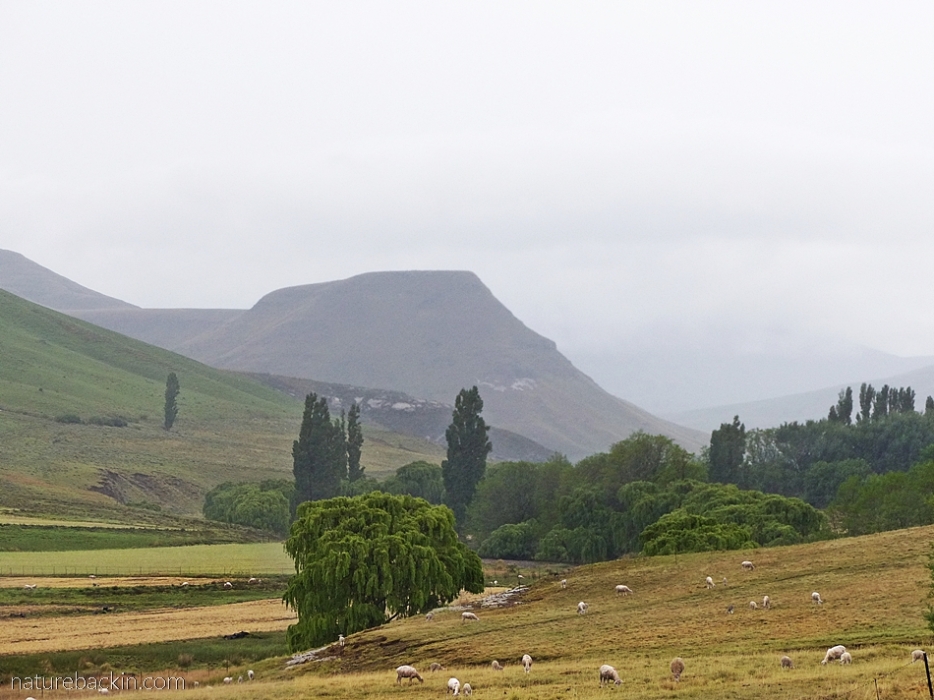
A view towards the village of Rhodes with willow and poplar trees being evident
By contrast I have been reading a paper on invasive alien plants in the Drakensberg Alpine Centre, and this study applauds the Working for Water (WfW) Programme of the Department of Water and Environmental Affairs (DWEA), which is one of the programmes proactively removing invasive alien plants that impact on water systems, a project of particular importance in mountain water catchment areas.
The paper’s list of invasive alien plants in the mountain regions includes, for example, the Crack Willow (Salix fragilis), and it notes that this willow uses huge amounts of water, has the capacity to spread prodigiously, and has other negative effects on waterways including slowing water flow or diverting the flow of water, which can cause erosion of river banks.
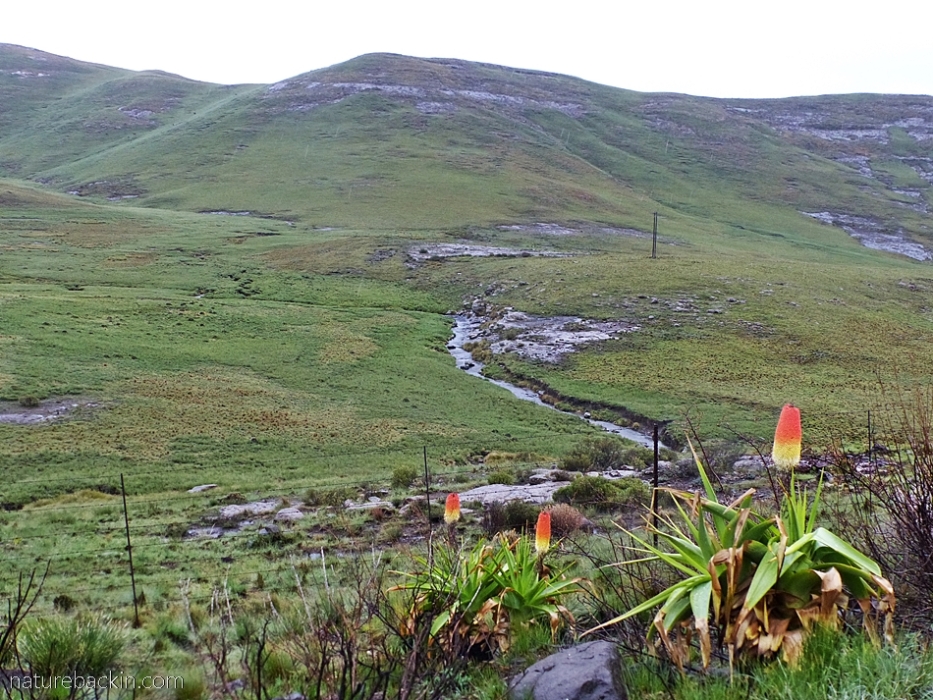
While we were travelling from the village of Rhodes towards Naudé’s Nek Pass, the mist lifted enough for us to have this view of montane grassland with a stream flowing fast after heavy rain. In the foreground are giant red-hot pokers (Kniphofia northiae) in flower
We were unlucky when we left Rhodes village heading towards Maclear on our homeward journey via the famous Naudé’s Nek Pass (summit 2 920 m) to have mostly thick mist and drizzle depriving us of seeing much of the scenery and spectacular views. So as a passenger I focussed on what I could see, which was largely the rather hair-raising bumpy and winding gravel road and the vegetation along the roadside.
I was intrigued by what appeared in the mist to be Ouhout bearing rose-like flowers. So we stopped and picked a sprig. I have since found out that Ouhout is a member of the Rose family, and the rose-bearing plant seen from the car window was in fact the alien (and invasive) Eglantine or Sweetbriar rose (Rosa rubiginosa) – a rosy relative of the Ouhout.
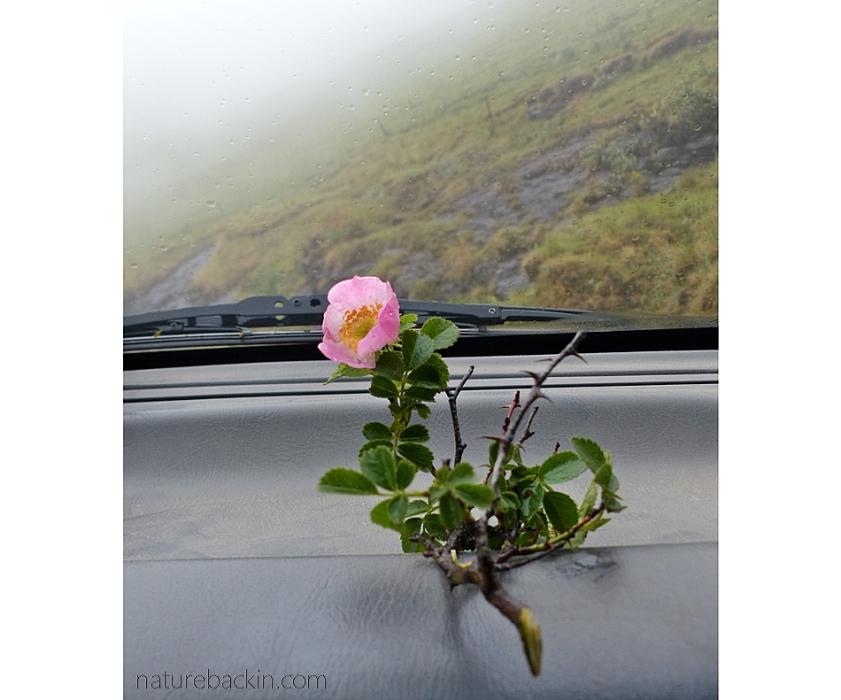
The sprig of the Sweetbriar rose that we picked on our way from Rhodes to the Naudé’s Nek Pass, photographed on the dashboard. I hoped to be able to identify it once we got home. Its leaves are fairly similar to the leaves of the Ouhout
So anyway, the visit to Rhodes gave me much to think about regarding the roles of indigenous and alien species of plants. Rhodes needs replacement trees to provide firewood, but perhaps a compromise can be sought where non-invasive trees that do not require huge amounts of water can be utilised.
The Sweetbriar rose has naturalised in large parts of South Africa and as it is highly invasive it has been declared a Category 1 invader plant, which means it is totally prohibited. However, its fruits (hips) can be considered to be of value and they have been harvested to make a syrup that is high in Vitamin C.
But back to the Ouhout, it too is a medicinal plant being widely used in traditional medicine. It has been shown to have antimicrobial, anti-parasitic, antioxidant and anti-inflammatory properties (see here). The wood has been used to make long-lasting fence posts. Although the wood can be used to start fires as kindling, it produces far too much smoke to make a good firewood.
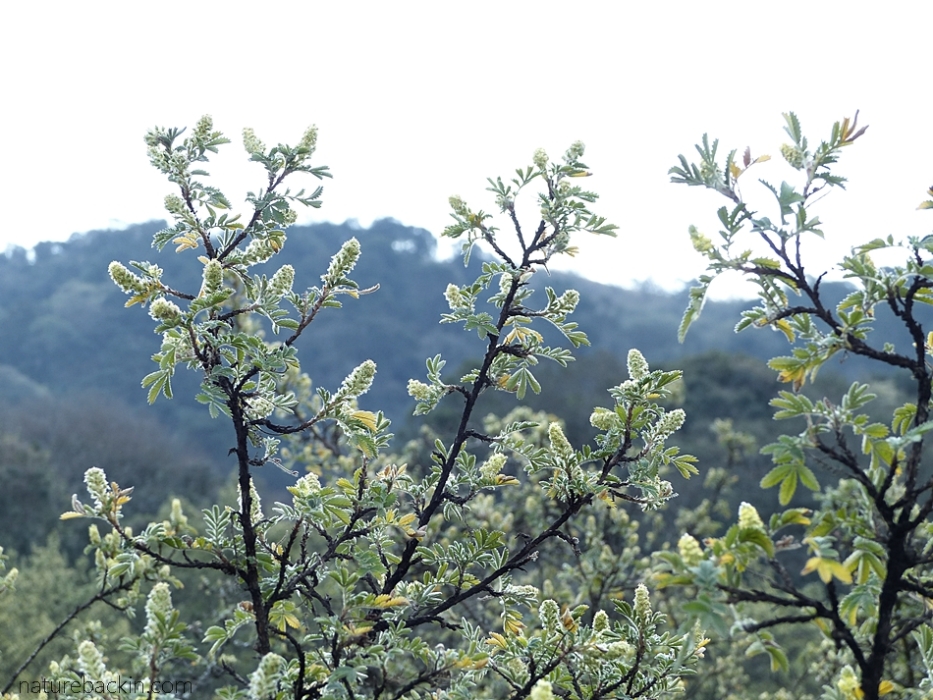
Ouhout in flower near Fort Nottingham in the KwaZulu-Natal Midlands. A patch of mistbelt forest is visible on a hillside in the background
The Ouhout seems to be a tenacious survivor. Among its other attributes of toughness is its ability to withstand wildfires. After being burnt it is largely able to regenerate.
And I am pleased to report that we have been able to propagate an Ouhout plant from a cutting. It is now doing well in a pot and we plan on planting it out in the garden after the first (hoped for) spring rains.
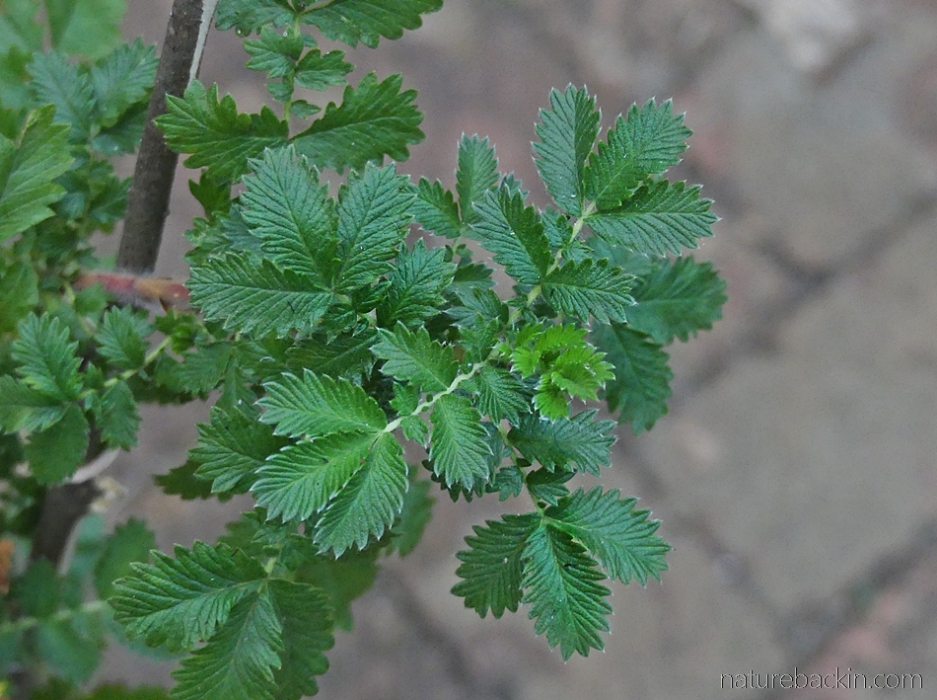
A close-up of the leaves of the young still-potted Ouhout that we grew from a cutting
While reading for this post I came across a post on the blog Under the Milkwood about a Rhodes village community-based initiative making face masks for distribution to mitigate against the spread of the novel coronavirus. I decided to share this link as a reminder that even remote villages like Rhodes are caught up in the global pandemic. Here are the details: Bennett, Janette. 2020. The mask makers of Rhodes Village and Zakhele. Celebrating ordinary people emerging as heroes of the COVID-19 pandemic. 9 April. https://underthemilkwood.co.za/the-mask-makers-of-rhodes-village-and-zakhele/
Sources: Becking, David. 2020. Leucosidea sericea. Tree SA. https://treesa.org/leucosidea-sericea/; Boon, R. 2010. Pooley’s Trees of Eastern South Africa. Flora and Fauna Publications Trust, Durban; Carbutt, Clinton. 2012. The emerging invasive alien plants of the Drakensberg Alpine Centre, Southern Africa. Bothalia – African Biodiversity and Conservation 42(2):71-85. https://www.researchgate.net/publication/262672578_The_emerging_invasive_alien_plants_of_the_Drakensberg_Alpine_Centre_Southern_Africa; Walker, D. 2006. A brief history of the village of Rhodes https://rhodesinfo.co.za/history/
Posted by Carol









August 26, 2020 at 8:25 pm
Interesting post, Carol. Love the leaves of the Ouhout and the clay tiles you discovered. The conundrum of indigenous vs invasive species is an important one. As much as I love Eucalyptus trees here, they fall into the invasive category, although they may not be as “bad” as something like Kudzu that has invaded our southern states. Agree about gardens that are not “of the place”! Terrific images and post. 🙂
LikeLiked by 1 person
August 27, 2020 at 1:32 pm
Thanks very much Jane. Yes the ongoing debates about the place of exotic plants are interesting and complicated, though less nuanced when it comes to invasives of course. I have just looked up Kudzu as I had not heard of it before. Vines look to be more graphically invasive even than thickets somehow!
LikeLiked by 1 person
August 27, 2020 at 2:13 pm
Yes! Kudzu covers and kills wherever it climbs. 😳
LikeLiked by 1 person
August 20, 2020 at 4:27 am
What a lovely tree. I find the wrinkled leaves to be fascinating and beautiful. We seem to be on much the same page. I am currently trying to start some local currant bushes from a twig. I tried several in pots, but they didn’t do well. Then stuck two in the ground and have kept them watered. One of them is sprouting new leaves. If I can just keep it going until our rains come hopefully sometime in September or perhaps October.
What lovely country you visited. I particularly liked the tree-lined street.
LikeLiked by 1 person
August 20, 2020 at 8:26 pm
I hope your currant bush continues to sprout and you keep it going until the rains come to the rescue, and indeed that the rains do come.
We are hanging on for our spring rains that should start in September.
LikeLiked by 1 person
August 15, 2020 at 8:42 am
Another fascinating post, thank you Carol. It struck me that Ouhout is an appropriate name because the trees and their branches look old and and gnarled. I am glad that you have managed to propagate an “offspring” of your garden tree. Your essay on indigenous versus alien trees has given me much food for thought.
LikeLiked by 1 person
August 20, 2020 at 8:00 pm
Thanks Mariss. Ouhout is a good name – so good that the English name has never really caught on it seems! We actually took a cutting from a tree in the Midlands as our original plant died before we thought about saving any ‘offspring’.
LikeLiked by 1 person
August 15, 2020 at 7:04 am
Ouhout trees really are synonymous with the wild places of the Drakensberg and surrounds, and you’ve done them beautiful justice with this post, Carol.
Marilize’s late grandfather hails from the north-eastern part of the Eastern Cape – Ugie to be precise – so we’ve given some thought about visiting there but just never got that far, yet. Your wonderful depictions of Rhodes (the town) has made me think about moving it up the ladder of must-do trips!
LikeLiked by 1 person
August 17, 2020 at 7:22 pm
It is definitely worth thinking about – the weather and road conditions need to be given some consideration though when planning a visit!
LikeLiked by 1 person
August 15, 2020 at 4:10 am
Before I moved to Hawaii I lived in Washington State. At my last place there I put in a tropical garden. Not exactly native, but I liked the colors and the big leaves. The risk of plants escaping and becoming invasive was negligible because most would die in the cold winter unless they were hardy or brought indoors.
I think the appeal of plants from elsewhere is that they’re something bright and shiny and new, and there’s room for that I think. The biggest problem is when people don’t have a grasp of the possible consequences or don’t care.
Here in Hawaii, we’re overrun with invasives, plants and animals. Some were deliberate introductions, some accidental, and it’s really hard to restore order to the situation. Happily, an appreciation for native plants here is growing and work is going on to restore areas to their native state. It will never be as it was – the horse has already bolted there – but it will at least preserve many plants so they’re not lost for ever.
LikeLiked by 1 person
August 17, 2020 at 7:14 pm
I agree we need to try to be a bit more aware of the consequences of our choices. And with our gardens we can find a happy mix of non-invasive garden plants and experiment more with using native plants. I celebrate and encourage growing indigenous because I am interested in gardening for birds and wildlife and conserving local biodiversity. For so long indigenous plants have have been regarded as somehow being inferior -although attitudes are slowly changing here too – when in fact they have many rewarding qualities.
LikeLiked by 1 person
August 19, 2020 at 6:02 am
I do think it’s mostly a case of familiarity. If you’ve seen something in a place since you grew up it’s kind of ho hum. But something flashy and new that you’ve never seen before, well gotta have that. I think the long term repercussions didn’t used to enter in to it, but people are a bit more aware of that now. The merits of native plants are being more appreciated and that can only be a good thing.
LikeLiked by 1 person
August 20, 2020 at 8:24 pm
Yes that is definitely the case that people like the exotic and something different and new. But paradoxically and parallel to that in our context here at least, the settlers from Europe in earlier colonial times brought with them familiar plants for their gardens so as to feel more at home and because these ‘proper’ garden plants were considered superior to most of the native plants growing wild here that were regarded more as weeds. In the region of South Africa where I live there is still an element of colonial cringe that makes folks plant, for example, “English country gardens” in the mistbelt gardens of KwaZulu-Natal. But more recently here too there is a move to appreciate and plant more indigenous plants in gardens, which is kind of refreshing given the context.
When I look at blogs from elsewhere I am always interested to see what is particular to a place or country rather than the garden plants that are utilized in rather homogenized gardens across the world.
LikeLiked by 1 person
August 21, 2020 at 5:02 am
The English country garden thing has a lot to answer for!
LikeLiked by 1 person
August 21, 2020 at 8:34 pm
And then of course there is also the song!
LikeLiked by 1 person
August 21, 2020 at 10:42 pm
You had to mention that! Now I’ll be humming it for two days.
LikeLiked by 1 person
August 22, 2020 at 4:07 pm
Hope its no more than two days!
LikeLiked by 1 person
August 14, 2020 at 11:27 pm
Exotics always held such cachet. The human desire for new and different (as well as ego-inspired ‘I have something you don’t’) created a huge problem worldwide that we are now dealing with. It was only fairly recently that anyone even realized what an ecological mess had been created. Now we’re trying to get the horse back in the barn. I try to eliminate as many as I can, but with a 100+ year head-start, the task is Sisyphean.
I hope Rhodes can find the right species that will help them meet their needs.
LikeLiked by 1 person
August 17, 2020 at 7:04 pm
So true what you say. In a cosmopolitan world it doesn’t make sense to be a purist about indigenous plants, but countering those invasive plants that threaten and even eliminate native species is indeed an ongoing (and uphill) battle.
LikeLiked by 1 person
August 14, 2020 at 7:00 pm
Ouhout … before I had even opened this post I was transported to the Drakensberg and the many hikes we enjoyed there whilst living in Pietermaritzburg. It is an iconic plant there! It is the thirstiness of some exotic species that is a real problem in this country and yet – as you rightly point out – in places such as you mention as well as in naturally ‘treeless’ areas such as large parts of the Free State, firewood is required as well as wind breaks and shade. This brings home the value of trees and the need to balance what they can give with the needs of the environment as a whole. I really enjoy those tiles made by Irene – she is a lovely person indeed.
LikeLiked by 1 person
August 14, 2020 at 7:49 pm
Glad to know the Ouhout and its place in the Drakensberg also resonates with you. The need for trees in ‘treeless’ areas is a complex problem and I agree that some kind of balance is needed.
The ceramics are great – I think that Irene spent quite a few years in Grahamstown some time back.
LikeLiked by 1 person
August 14, 2020 at 3:01 pm
Lots to think about here. You may not have the problems that many areas of Britain have in places where stately homes made a feature of their gardens. The owners looked world-wide for splendid specimens to grace these gardens. And it’s when they escaped that problems began. Many areas of Britain, and especially in Wales have a real problem with rhododendrons. Who doesn’t love a rhododendron in flower? Well, a Welsh hillside, and English woodland which can easily be strangled out of its diversity by this rampant plant. It’s all quite complicated.
LikeLiked by 2 people
August 14, 2020 at 3:30 pm
We have similar problems here as since colonial times landowners have brought in their favourite trees and ornamentals from elsewhere and several of those have become invasive. Other invasive plants arrived less deliberately in fodder and so on.
I was not aware of rhododendrons becoming invasive in the UK but having seen them in enormous stands on country estates there, I can imagine the problem when they naturalize in woodland. Judging from their relatives, azaleas, which are more common here (though not so invasive here to my knowledge) they can be quite toxic too? I can never understand why indigenous plants so often are not valued in their home countries, and yet they are often coveted when they are exported elsewhere!
LikeLiked by 1 person
August 14, 2020 at 3:34 pm
Yes, it’s all quite odd, It’d s hard to imagine who thought it would be good idea to bring Himalayan balsam over here. It mow chokes anything at all it grows near on river banks and beyond, I walked through a 7 foot high corridor of the stuff only the other day. Couldn’t see a thing!
LikeLiked by 1 person
August 14, 2020 at 7:45 pm
Wow – I just looked up Himalayan balsam. Trying to imagine 7-foot-high Busy Lizzie’s exploding their seeds far and wide. Sounds to be an awful problem.
LikeLiked by 1 person
August 14, 2020 at 7:47 pm
It really is. Many communities organise ‘balsam bashing’ sessions, which can be satisfying, but have to be done religiously for at least five years to make an impact.
LikeLiked by 1 person
August 14, 2020 at 7:50 pm
What an immense and ongoing problem.
LikeLike
August 14, 2020 at 2:24 pm
Carol I love the information you add in your posts and as always found this blog very interesting, thank you! I so enjoy our Ouhout trees, particularly when the tiny yellow flowers appear. They are definitely pioneer plants, in an area we haven’t burnt off since we moved here, both Ouhout and Budleja have created a small ‘forest’ which the birds and antelope use. Love, Christeen xxx
LikeLiked by 1 person
August 14, 2020 at 3:17 pm
Thanks Christeen. The Ouhout is magnificent when it flowers, especially when they cover a widespread area. They and the Budleja go so well together – lovely to imagine your haven for birds and antelope. Our Budleja are still tightly budded! But the white pear (Dombeya) is flowering and of course the Greyia sutherlandii – much to the delight of the sunbirds and the vervets, and us too of course. Let’s hope KZN gets spring rains soon xxx
LikeLike